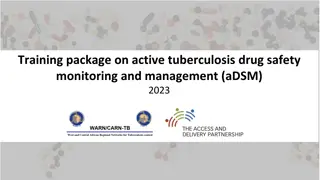Comprehensive Training Package on Active Tuberculosis Drug Safety Monitoring and Management (aDSM) 2023
This training package focuses on signal detection in active tuberculosis drug safety monitoring. It covers the main aims and principles of signal detection, completion of safety profiles for new TB drugs and regimens, definition of signal, continuous reporting activities, construction of risk profiles, and pointers for investigation. Emphasis is placed on data quality, credibility of relationships between events and drugs, regulatory actions, and the importance of thorough observation in signal detection.
Uploaded on Aug 27, 2024 | 5 Views
Download Presentation

Please find below an Image/Link to download the presentation.
The content on the website is provided AS IS for your information and personal use only. It may not be sold, licensed, or shared on other websites without obtaining consent from the author. Download presentation by click this link. If you encounter any issues during the download, it is possible that the publisher has removed the file from their server.
E N D
Presentation Transcript
Training package on active tuberculosis drug safety monitoring and management (aDSM) 2023
Learning objectives By the end of this presentation, the participant is expected to be able to: 1. Describe the main aims and principles of signal detectiona 2. Describe the completion of safety profiles for new TB drugs and regimens
Signal detection (1) One of the main reasons we collect aDSM data
Definition of signal Reported information on a possible causal relationship between an AE and a TB medicine The relationship was previously unknown or incompletely documented (e.g. a new aspect of a known association) Signal detection is based on analyses of multiple data points
Reporting (1) Signal detection is a continuous activity Analysis for completeness consistency timeliness number and type of events per facility and nationwide patterns over place and time Related to the number of patients exposed
Reporting (2) Construction of risk profile Definite, probable and possible relationship Communication to NTP and all DR-TB facilities Signal detection would best be done over a large set of observations
Pointers for when to investigate Data quality is reliable Several reports show a credible and strong relationship between event and drug The event is of sufficient importance or interest : to require regulatory action to require advice to prescribers for scientific /clinical purposes
Features Usually >1 event with a similar, strong relationship to a medicine ( certain or probable ). Events coded as possible can be used as supporting evidence A cluster of unexpected deaths coded as possible forms an exception to this general rule and will need to be taken seriously Occasionally a single event ( certain or probable ) - notable for its severity, seriousness or distinctiveness - can be regarded as a signal
Methods of signal identification Clinical assessment of individual events Clinical review of collated events Record linkage Automated signal detection
Drug-safety profile (1) definition Drug-safety profile: A description of the benefits, risks and toxicity of a given TB drug or regimen, specifying any known or likely safety concerns, contraindications, cautions, preventive measures and other features that the user should be aware of to protect the health of a TB patient
Drug-safety profile (2) adding new knowledge on benefits & harms
Creating new knowledge National TB programme Pharmaconvigilance programme Drug safety monitoring (aDSM Component) Further analysis for signal detection/causality assessment and communication TB-MR treatment facility Cohort-based follow-up of patients with questionnaires to elicit symptoms; and routine tests for TB drug safety monitoring Delivery of treatment Management of adverse reactions Reporting as required by local regulations Recording of all SAEs in a national aDSM database (regularly transferred into the global database) Signal detection/causality assessment by the NTP (if capacity is limited by national pharmacovigilance system (NPV)) Support for signal detection and causality assessment Inform updates of country and global drug safety profile Inform update of treatment policy and patient care practice (as per PMDT guidance) New evidence
Conclusions Signal detection is an important process to improve knowledge on the new TB medicines and complete the safety profile of a new drug When monitoring AEs it is important to look beyond adverse reactions and biological pathways already linked to particular drugs: previously unknown or rare associations may occur, especially for newly released drugs Reports of adverse events to the global aDSM database is expected to improve the likelihood of picking up signals
Acknowledgements The development of the aDSM training material was funded by TDR as part of the Access and Delivery Partnership (ADP) with funding from the Government of Japan. These training materials were put together in 2016 the WHO Task Force on aDSM with technical partners KNCV Tuberculosis Foundation, Management Sciences for Health (SIAPS), MSF, WHO GTB, and TDR. The materials were updated in 2022-23 by Mahamadou Bassirou Souleymane (TDR consultant) with Marie-Eve Raguenaud (TDR), Branwen J Hennig (TDR), and Corinne Merle (TDR), and reviewed by Linh Nhat Nguyen (WHO/GTB), Medea Gegia (WHO/GTB), and Fuad Mirzayev (WHO/GTB). We thank all members of the WARN/CARN-TB working group on aDSM who contributed to the development of the aDSM generic guidelines as well as the secretariat, particularly Dr Christ Houessinon: Disadidi Ambrioso, Esse Marius, Adomou Jamal Rouamba Ruffine, Haro Sougrimani, Koumbem Boureima, Nsanzerugeze Jos lyne, Tollo Tollo Daniel Alphonse D sir , Mpaba Minkat Th ophile Mistral, Julie Abessolo, Ursule IDOKO, Tijan Baldeh , Wandifa Samateh, Tida S Kinteh, Alieu Wurie, Mardemn Yeasuen, Benjamin K. Quenneh, Cheick Oumar Bah, Kane El Hadj Malick, Aw Idriss, Mamoudou Hama Rachida, Gagara I. M. Assiatou, Katamb Balkissa, Seiyabatou ElhSaidou, Liombo Anastasie, Lunganyu Junior, Kitambala Sentime, Lula Yves , Habimana-Mucyo Yves, Migambi Patrick, dos Santos Brigite, Castro V nia, Wadson Cruz, Gueye Aminata, Mukeh Fahnbulleh, Bailor Samuel, Manjo Lamin, Saleh Mahareb Abdoulaye, Haroun Saleh Naima, Mouhoudine Yerima, Kpelafia Silifa























